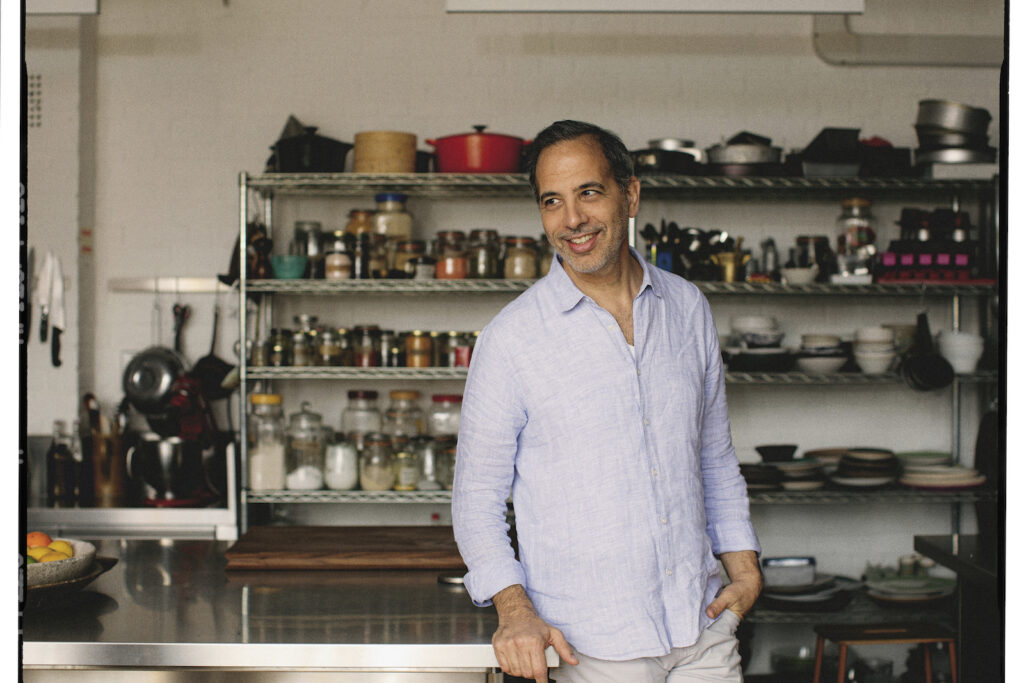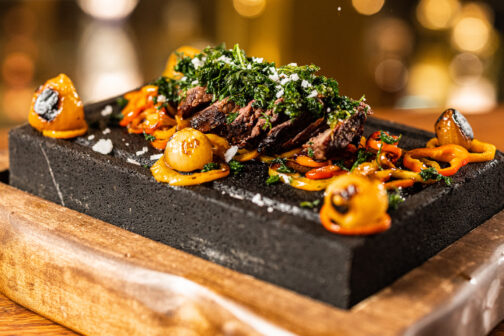Yotam Ottolenghi is one of the most influential cookbook writers in the world today. His London restaurants, which range from high-end cooking to takeaway delis, have inspired a series of nine cookbooks, plus television specials and newspaper columns in the New York Times and the UK’s Guardian.
More than sales numbers, though, Ottolenghi’s effect on home cooking can be measured in cultural changes. British groceries began stocking new ingredients and spices in response to his recipes, which are often inspired by his Israeli heritage and the Middle Eastern diaspora foods he grew up eating. And although the chef isn’t vegetarian, books like Plenty and Simple have taught home cooks around the United States and Europe to lavish more love on veggies like eggplant, endive, and chard.
On May 3, Ottolenghi appears at the Eisemann Center in Richardson, hosted by the Dallas Museum of Art. It’s nominally part of a book tour for his latest, Flavor, co-written with the chef Ixta Belfrage, but Ottolenghi is a serious thinker who can talk his way across the map, from favorite veggies to the power of food to bring people together.
He’ll be joined onstage by Chad Houser, chef-founder of Cafe Momentum, the beloved Dallas restaurant that provides juvenile offenders with job training and a chance to get back on track. Houser and Ottolenghi are an inspired pairing: two people who know food’s ability to create bigger change.
To get an appetizer, I chatted with Ottolenghi over Zoom earlier this week. The chef was in his London test kitchen, working on his New York Times column, which recently moved from the food section to the glossy color pages of the paper’s Sunday magazine.
We spoke about the cookbook writing process, culinary idealism, the joys of cheap chocolate, how to get everyone to eat more veggies, the real problem with fast food, and how to tempt a city with conservative eating habits (cough) into trying new things. If there is a theme to the conversation, it is that optimism, delicious flavors, and a good story can change the way people eat.
(This interview has been edited for length and clarity.)
What is a step in the cookbook making process that probably most readers or home cooks don’t think about?
First of all, just the whole process of doing books is long. My books take about two years from start to finish. We check recipes over and over and over again. Every recipe is tested here three or four times at the very least, and sometimes up to, I don’t know, 10 times? And then it goes out to an outside tester. That tester actually tests the recipe on her family, so her husband and kids have the dish and then she sends a report. She might send it back for an extra test.
When we test recipes here in the test kitchen, we always use very simple, humble ingredients. We always get them in the local supermarkets that we have around us or we order them online from the market. I want to know exactly what it would be like for any person who cooks the recipe, not just someone who has top ingredients. It is very easy to get a tomato at the heart of summer that is really good and delicious and imported from Italy, and you just know they’re gonna be good. But most people wouldn’t have that at their disposal. They might have midwinter tomatoes that are a bit orange and don’t have all the flavors in the world.
There are a lot of cookbooks around that come out of restaurants and I often feel that in these books, it’s almost about getting people to change the way they cook at home. Creating standards that are not always necessarily achievable for home cooks, or at least not achievable for day-to-day cooking. I wouldn’t say my recipes are simple, they’re not, or not always, but they’re very achievable, they’re not technically challenging. And they’re tested and tested and tested until they’re right.
Something else is different about your cookbooks. You have so many collaborators and co-authors, it’s a group effort, even if your name is on the cover.
I’ve always been a collaborator. It started off with Sami [Tamimi] and we were together for the first Ottolenghi cookbook and Jerusalem. The Plenty books I did more or less on my own, but since then every book that I’ve published has been a collaboration. Because I’ve published quite a few books now, I really want the books to be different from each other. So that it doesn’t feel like, “oh, yeah, another Ottolenghi cookbook that’s very much like the last one.”
When there is a collaboration and the spirit of a different writer comes into the book, I feel it creates a very different book. Flavor has a lot of flavors that I wouldn’t have been introducing in the cookbook. Ixta [Belfrage] spent much of her youth in Mexico because her grandfather lived there, and she has a really, really good understanding of Mexican food, which I really don’t. I think that made the book really interesting because it had so much of this angle.
I think a lot of people talk about your work as if it’s a big mission. That you have a mission to change food culture or teach people. Did you start out thinking that way? Do you now think that way?
No. I write about food out of the joy of food, and the joy of food is all about inclusivity and being accommodating. This is still my approach. I don’t want to tell people what to do because I think they should make their own choices.
For instance, my whole attitude to vegetables is, I think they’re great and I think you can do incredible things with vegetables. There’s all the ways of treating vegetables, all the ways of cooking them, all the pairings that you can have with other flavors and other ingredients. That should be the approach, rather than telling people, ‘oh, you should be going full vegetarian.’ It’s very important to eat less meat and I think as a society we should be eating less meat. But there’s a cleverer way of saying it. I personally much prefer to present the positive aspects of my way of eating. And as a non-vegetarian, I can’t even claim that you should make certain decisions. You should do what you want.
It’s extremely important for us, for society, to make small changes and to make big changes now, for the planet and for ourselves, but I’m not preaching. And I think it is really important to be inclusive in the way I cook, the way I talk about food, the way I present my food.
Sometimes in the past people said, “your mission is to get people to eat more ingredients that you grew up with in the Middle East.” I was exposed to various ingredients that I absolutely loved growing up, both from the Jewish culture and from the Arabic cultures that I grew up in, yes. But it’s a bit like the vegetables that are really amazing ingredients. Some of those are really hard to get, so I would always offer a substitute. If you can’t get za’atar, or fresh oregano, it’s not a reason not to cook the dish if you’re missing one ingredient.
So yeah. It looks like I have a mission because I published all these books, but it’s more out of passion.
You’ve talked in the past about how London was a very conservative food city when you got there. Boiled meat, boiled broccoli. Dallas has a reputation as the steak city, the burger city, the meat capital. Chefs tell me it’s hard to convince people or persuade people, or they say, for example, you can’t open a restaurant without a cheeseburger on the menu. I wonder what you would say to people who are trying to expand palates in a city that’s fairly conservative.
I think it’s very important not to alienate anyone. If I want my kids to watch less TV, the worst thing I can do is take away the TV. But I think opening up to new experiences is really important.
I grew up in the Middle East, where meat is not as central as it is in other cultures. It’s not a central thing in the meal. So often meat is used as a seasoning, as a stock, or maybe use a tiny bit of it just to flavor something bigger. If you have a really good meal that comes out of India or parts of the Middle East or Asia, you see that you can cook an incredible feast with very little meat or no meat. This would be the opening argument, not take away the cheeseburgers.
Maybe it’s a global process, maybe people will understand just because they will be exposed over time. You know, you can have a plate of really delicious hummus or an eggplant salad and pita. I do eat meat, and I will have a nice cheeseburger. Probably when I come to Dallas I’ll have a nice idea of where to go [get one]. But I don’t have to have it every meal.
Was there an example of a time where you tried to bring something that you thought would be new or interesting, and it didn’t work at first and you had to retry?
The guests that come to our restaurants are quite open-minded, but a certain dish that they don’t adopt wholly-hearted is internal organs. Livers, hearts. We would throw them on the menu once in a while, but they wouldn’t last very long.
Although in my restaurant Rovi, we have a dish called the Jerusalem Mixed Grill, which is a bunch of bits–chicken livers, chicken thighs–and those are all cooked together on the grill, with lots of spices, like cumin, turmeric, allspice, and a lot of grilled onion as well. We serve this with homemade pita and pickles and that’s super popular. It’s been on the menu since we opened.
It helps that it’s got a very good, attractive name.
And it’s a traditional dish. In the old city, when I was growing up, there were a couple of steakhouses; they used to call them that but not in the way you know steakhouses. These were joints where many cab drivers would stop in the middle of the night and have food like this Jerusalem mixed grill, the freshly-grilled chicken bits, onions, pita, and all that. And it was absolutely delicious. That’s why we called it that, because it’s that particular dish.
If you have a really good meal that comes out of India or parts of the Middle East or Asia, you see that you can cook an incredible feast with very little meat or no meat. This would be the opening argument, not take away the cheeseburgers.
Yotam Ottolenghi
You have a new column in the New York Times Magazine, and one thing I loved about that first entry was you make a distinction between being selective and being a snob. That is very good life advice in general.
It’s very easy for someone who’s kind of surrounded by food, good food and good ingredients, to become a little bit snobbish and aloof about it, and say, I eat certain things, I don’t eat these things. I see people say those things around me, but I realized that often, it is about the effort that goes into a dish. I am happy to eat everything and anything, as long as it’s good, and a genuine effort has gone into it. That’s kind of my motto.
As long as you’re open to new flavors and experiences, there’s no reason to be snobbish about it.
Also being snobby is about other people and being choosy is about yourself, right?
It’s a statement to the rest of the world, snobbism, isn’t it? I mean, we all secretly love a lot of things that we find hard to admit that we love. I eat chocolate, a lot of chocolate, and I like good quality chocolate. But also not such good chocolate!
Like the Cadbury chocolate eggs at Easter.
Yeah, I ate a lot of those this Easter. My kids were doing all the Easter activities, and I had a lot of those.
Do you have any cooking “rules”? Like traditional lessons you learned from family? My family has a rule, every plate has to have three colors on it. If there are only two colors, you add parsley or something to get to three.
Did your family invent Instagram? (laughs) For us, it’s all about layering of flavors and layering of ingredients. The salads we sell in our shops are about layering. I think it’s really important that the experience is multifaceted. So you have something crunchy, something sharp, something red, green. It all translates to the flavor.
We eat such uniform diets, as a culture. With fast food, we kind of closed down how much different food we eat over time. We reduced our food’s diversity. Adding an ingredient, adding a garnish, it’s almost like opening a little world for yourself.
Get the SideDish Newsletter
Author






